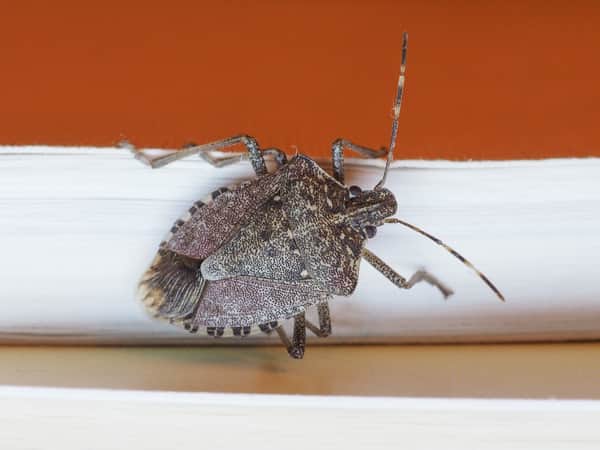
Stink bug control begins with knowing your enemy. Stink bugs are in the order Hemiptera, which includes many other insects such as assassin bugs and plant bugs. These insects all share common characteristics. These include mouthparts made for piercing and sucking and wings that are soft at the tips, but hard at the base. Of the many species of stink bugs found throughout the world, some feed exclusively on plant materials while others feed primarily on pests such as caterpillars. Some of these predatory stink bugs are considered beneficial insects in crops and gardens.
Stink bugs tend to prefer the great outdoors, but when the temperatures start to drop they’ll consider seeking shelter and warmth inside of homes and office buildings. As their name suggests, stink bugs can emit a smelly scent if they feel threatened or if you squish them. Additionally, an infestation can be downright annoying,
STINK BUG IDENTIFICATION
Stink bugs come in a variety of sizes and colors, but their shape is similar throughout the different species. Their bodies are broad with a triangular shape and the wings appear more like a shield rather than conventional wings.
ARE STINK BUGS HARMFUL?
Stink bugs aren’t known to cause structural damage to homes, nor do they bite people. However, they can cause substantial damage to food crops and trigger allergic reactions in some people.
That being said, these insects can become a nuisance if they enter your home or office building. They’re notoriously difficult to control and will gather almost anywhere, including under beds, beneath couches, behind baseboards and in attics. Additionally, stink bugs can enter your home or office in clusters.
WHAT DO STINK BUGS EAT?
Many stink bugs are vegetarians and feed on various leaves, fruits and vegetables, including apples, peaches, citrus, corn, beans, soybeans and even cotton and field crops. Their dietary preferences give them a reputation for being significant agricultural pests across the United States, and they have been known to cause damage to crops to such extremes that produce becomes unmarketable.
However, there are some species of stink bugs, like the rough stink bug, that home gardeners actually try to attract because these insects eat pests — such as caterpillars, beetles and other bugs — that can cause damage to plants.
STINK BUG CONTROL MEASURES
One of the most common species of stink bugs in the United States is the brown marmorated stink bug. Getting rid of stink bugs of this species – as well as other types of stink bugs – mainly involves removing the insect’s prime harborage areas. It may also involve the use of pesticides, which should be handled by pest management professionals.
Stink bugs and other pests can enter structures through small openings around your home. If they do get in, the United States Environmental Protection Agency advises:
‟Both live and dead … stink bugs can be removed from interior areas with the aid of a vacuum cleaner, but the vacuum may smell of stink bugs for a period of time. Although aerosol-type sprays and foggers labeled for domestic stink bugs will kill these pests in living areas, it will not prevent more of the insects from emerging from cracks after the room is aired out. Use of these materials is not a solution for long-term management of stink bugs.”
The site goes on to suggest these tips to help keep stink bugs out of your home:
- Make sure all doors have weather strips and door sweeps, especially if you can see daylight around the door’s perimeter.
- All debris and vegetation should be raked back from the foundation of your home to prevent easy access for pests.
- Perform regular inspections of your home’s foundation and seal up all cracks and possible points of entry.
- For larger gaps around plumbing pipes that can’t be caulked, use steel wool to eliminate entry points.
- Place screens on vents.
- Entrances for crawl spaces should be secured and sealed off to pests.
- All homes with fireplaces should have a cap or screen at the top of the chimney to prevent pests from crawling down.
- Vegetation surrounding your home and property should be treated by a pest management professional.
As mentioned above, stink bugs are known for being incredibly difficult to control once they’ve made their way into your home or office. If you see stink bugs, you can simply sweep them up with a broom and dust pan — taking care not to squish them, of course — and carry them away from your house.
Also, you should avoid using a vacuum to remove stink bugs, as the strong odor they emit may stick and essentially ruin your machine.
